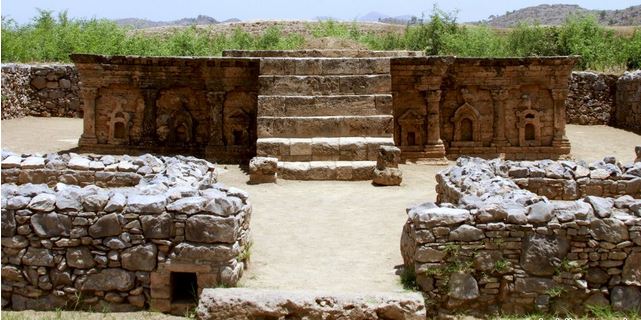World's First University, Takshashila (Taxila)
India has a long and venerable history in the field of higher education. In ancient times, the country was known to have been home to the oldest formal universities in the world.
The world's first University was established in Takshila or Taxila or Takshashila (now in Pakistan) in 700BC. This centre of learning was situated about 50 km west of Rawalpindi in Pakistan. It was an important Vedic/Hindu and Buddhist center of learning. It was not a well organized university like Nalanda.
There is some disagreement about whether Takshashila can be considered a university. While some consider Taxila to be an early university or centre of higher education, others do not consider it a university in the modern sense.

More than 10,500 students from all over the world studied here. The campus accommodated students who came from as far as Babylonia, Greece, Arabia and China and offered over sixty different courses in various field such as science, mathematics, medicine, politics, warfare , astrology, astronomy, music, religion, and philosophy. Generally, a student entered Takshashila at the age of sixteen. Students would come to Takshila and take up education in their chosen subject with their teacher directly.
They were supposed to pay for their expenses. However, if a student was unable to pay then he could work for his teacher. The Vedas and the Eighteen Arts, which included skills such as archery, hunting, and elephant lore, were taught, in addition to its law school, medical school, and school of military science.
Takshila was specialized in the study of medicine.
Panini, the famous Sanskrit grammarian, Kautilya (Chanakya) and Charaka, the famous physician of ancient India, and Chandragupta Maurya were the products of this university. It gained its importance again during the reign of Kanishka. It was probably, the earliest of the ancient seats of higher education. Takshashila is perhaps best known because of its association with Chanakya. The famous treatise Arthashastra (Sanskrit for The knowledge of Economics) by Chanakya, is said to have been composed in Takshashila itself.
Taxila has been listed by the UNESCO as one of the World Heritage Sites.

- Not only Indians but also students from as far as Babylonia, Greece, Syria, Arabia, Phoenicia and China came to study.
- 68 different streams of knowledge were on the syllabus.
- A wide range of subjects were taught by experienced masters: Vedas, Language, Grammar, Philosophy, Medicine, Surgery, Archery, Politics, Warfare, Astronomy, Astrology, Accounts, Commerce, Futurology, Documentation, Occult, Music, Dance, etc.
- The minimum entrance age was 16 and there were 10,500 students.
- The panel of masters included renowned names like Kautilya (the author of the “Arthashastra”), Panini (the codifier of Sanskrit into today’s form), Jivak (medicine) and Vishnu Sharma (author and compiler of the Panchtantra).
AUTONOMOUS UNIVERSITY!
- No external authorities like kings or local leaders subjected the scholastic activities at Takshashila to their control.
- Each teacher formed his own institution, enjoying complete autonomy in work, teaching as many students as he liked and teaching subjects he liked without confirming to any specific centralized syllabus.
- Study terminated when the teacher was satisfied with the student's level of achievement.
- Financial support came from the society at large, as well as from rich merchants and wealthy parents.
- Guru Dakshina was usually expected at the completion of a student's studies, but it was essentially a mere token of respect and gratitude - many times being nothing more than a turban, a pair of sandals, or an umbrella.
MEET THE ALUMNI OF TAKSHASHILA UNIVERSITY!
Takshashila's famous researchers and teachers include:
1. Panini the great grammarian of Sanskrit, to whom Prof. Noam Chomsky of MIT attributes the origin of linguistics.
2.Kautilya, also known as Chanakya (King-maker, Superb political advisor, and Author of ArthaShastra 300 BCE), deemed by social and economic historian Max Weber as one of the greatest political state-craft books of the ancient world.
3. Charaka the distinguished physician, whose research on the region’s flora and fauna described in his Charaka-Samhita strengthened the development of Ayurveda.
4. Jivaka the great physician of Bimbisara who cured the Buddha, learnt the science of medicine under a far-famed teacher at Takshashila and on his return was appointed court-physician at Magadha.
5. Jotipala, son of the Purohita of the king of Banaras, returned from Takshashila with great proficiency in archery or military science and was later appointed commander-in-chief of Banaras.
6. Prasenajit, the enlightened ruler of Kosala, who is intimately associated with the events of the time of the Buddha.